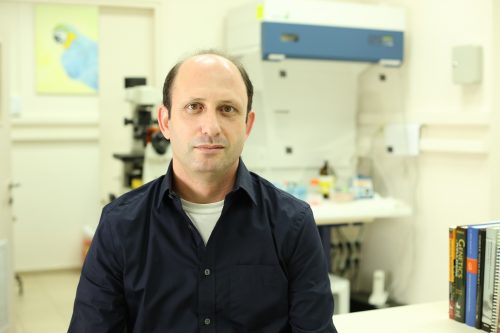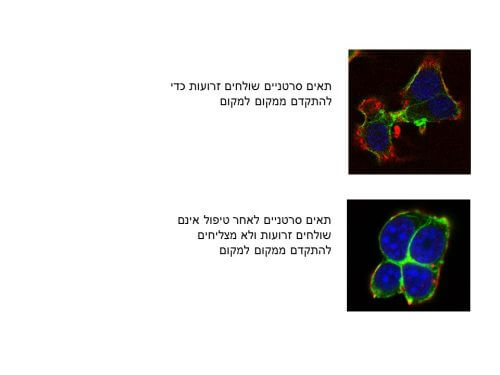The researchers used genetic material of the micro-RNA to 'silence' specific genes that allow cancer cells to migrate in the bloodstream to other areas of the body

Research conducted at Tel Aviv University, in collaboration with a laboratory at MIT, uses genetic material of the micro-RNA type to 'silence' specific genes, which allow cancer cells to change their shape and migrate in the bloodstream to other areas of the body. The promising result: tumors in mice treated in this way did not metastasize!
"Breast cancer is the second leading cause of death among all types of cancer among women, and one out of every 8 women in the world will develop it during her lifetime," says the leader of the study, Dr. Noam Shomron from the Tel Aviv University School of Medicine. "Scientists all over the world are investing enormous efforts in developing advanced treatments for the disease, but success is extremely limited: patient survival at the end of 5 years from diagnosis has increased by only 3% in the last 20 years, and the chances of recovery decrease significantly after the development of metastases. Our research brings a new approach to the critical issue: while most existing treatments attack the primary breast tumor, we decided to focus on metastases, and prevent their formation. If we can make the cancer stay local, we can treat it much more effectively."
Dr. Natalie Artzi from MIT, and two researchers from Dr. Shomron's lab also participated in the study: PhD student Avital Gilam and Dr. Dafna Weisglass-Volkov.
The study was published yesterday (19.9.16) in the prestigious journal Nature Communications.. Also, the research was recently presented by Dr. Shomron at the TEDx conference in Moscow, and will be presented to hundreds of commercial-medical stakeholders at a conference in Germany at the end of September.
stop the traffic
According to their innovative concept, the researchers looked for a way to damage the movement mechanism of the cancer cell, so that it cannot migrate from the primary tumor to vital organs in the body. "Toward the migration, there are changes in the shape of the cell skeleton," explains Dr. Shumron.
"The cell shrinks, with the aim of infiltrating into the bloodstream, which will carry it to the new site in the patient's body. When the cell reaches its destination, it changes its shape once more, in order to leave the blood vessels and take root in the new place. We uncovered the genetic mechanism that creates these changes in cancer cells, and we looked for a way to neutralize it - in order to stop their movement." The means chosen to neutralize the mechanism is micro-RNA - a genetic material that exists naturally in cells, and is responsible for 'silencing' gene expression.
In the first step, the researchers sought to locate the specific genes involved in changing the shape of the cancer cell. They did this using advanced computational tools from the field of bioinformatics. Says Dr. Shomron: "We examined a huge amount of data from databases in Israel and the world, and cross-referenced four types of data: DNA mutations that characterize breast cancer; A subset of genes responsible for changing cell shape; Genes with binding sites for micro-RNA controllers, which silence gene activity; and clinical data on mutations actually found in breast cancer patients, received from Prof. Eitan Friedman from Sheba Hospital in Tel Hashomer.

After crossing the data, a specific gene belonging to all four groups was identified. Silencing this gene, the researchers hypothesized, would significantly impair the cancer's ability to move and metastasize. To test the assumption, they produced two types of microRNA molecules, which are naturally responsible for controlling and silencing the relevant gene, and tested the new treatment on female mice in a breast cancer model.
"Free from secondary growths"
The female mice that participated in the experiment were divided into four groups: two groups were treated with the two types of microRNA that silence the identified gene, another group was treated with a non-specific mixture of microRNA molecules, and the fourth group was not treated at all. The treatments were performed by injecting a gel, prepared at MIT, containing the substance into the primary tumor environment.
The treated laboratory animals underwent a cycle of treatments simulating that of women in an oncology clinic: the primary tumor was surgically removed 48 hours after the 'diagnosis' and the experimental treatment, and three weeks later an audit was performed to detect metastases.
The model animals were CT-scanned and examined under a dedicated microscope, and some were sent to a pathologist for examination. The results were very impressive.
Dr. Shomron describes, "The female mice treated with microRNA were almost completely free of secondary tumors. In the control groups, on the other hand, many cancer cells were observed, which spread to all parts of the body. This means that we were able to stop the spread of cancer in the mouse model. We believe that the new treatment we developed, which has been proven to be effective in laboratory animals, has the potential to also help women with breast cancer due to the great similarity between the genes observed in mice and the same genes in cancerous tumors in sick women."
Now, as part of follow-up studies, Dr. Shomron and his group are checking where and how exactly the treatment has an effect: does the microRNA wrap around the primary tumor, bind to the target sites, and prevent cancer cells from being sent into the bloodstream? Does it act on the malignant cells even during their 'journey' in the blood? And is it also effective for the treatment of metastases that have already settled in the new site? The results of these studies may lead to the beginning of the process of developing innovative and effective drugs for breast cancer.
Lecture by Dr. Noam Shomron at a conference in Moscow:
